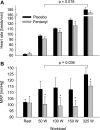Group III and IV muscle afferents contribute to ventilatory and cardiovascular response to rhythmic exercise in humans
- PMID: 20634355
- PMCID: PMC2963332
- DOI: 10.1152/japplphysiol.00462.2010
Group III and IV muscle afferents contribute to ventilatory and cardiovascular response to rhythmic exercise in humans
Abstract
We investigated the role of somatosensory feedback on cardioventilatory responses to rhythmic exercise in five men. In a double-blind, placebo-controlled design, subjects performed the same leg cycling exercise (50/100/150/325 ± 19 W, 3 min each) under placebo conditions (interspinous saline, L(3)-L(4)) and with lumbar intrathecal fentanyl impairing central projection of spinal opioid receptor-sensitive muscle afferents. Quadriceps strength was similar before and after fentanyl administration. To evaluate whether a cephalad migration of fentanyl affected cardioventilatory control centers in the brain stem, we compared resting ventilatory responses to hypercapnia (HCVR) and cardioventilatory responses to arm vs. leg cycling exercise after each injection. Similar HCVR and minor effects of fentanyl on cardioventilatory responses to arm exercise excluded direct medullary effects of fentanyl. Central command during leg exercise was estimated via quadriceps electromyogram. No differences between conditions were found in resting heart rate (HR), ventilation [minute ventilation (VE)], or mean arterial pressure (MAP). Quadriceps electromyogram, O(2) consumption (VO(2)), and plasma lactate were similar in both conditions at the four steady-state workloads. Compared with placebo, a substantial hypoventilation during fentanyl exercise was indicated by the 8-17% reduction in VE/CO(2) production (VCO(2)) secondary to a reduced breathing frequency, leading to average increases of 4-7 Torr in end-tidal PCO(2) (P < 0.001) and a reduced hemoglobin saturation (-3 ± 1%; P < 0.05) at the heaviest workload (∼90% maximal VO(2)) with fentanyl. HR was reduced 2-8%, MAP 8-13%, and ratings of perceived exertion by 13% during fentanyl vs. placebo exercise (P < 0.05). These findings demonstrate the essential contribution of muscle afferent feedback to the ventilatory, cardiovascular, and perceptual responses to rhythmic exercise in humans, even in the presence of unaltered contributions from other major inputs to cardioventilatory control.
Figures





Comment in
-
Control of breathing during dynamic exercise by thin fiber muscle afferents.J Appl Physiol (1985). 2010 Oct;109(4):947-8. doi: 10.1152/japplphysiol.00892.2010. Epub 2010 Aug 5. J Appl Physiol (1985). 2010. PMID: 20689092 No abstract available.
-
Has intrathecal fentanyl no effects during arm exercise?J Appl Physiol (1985). 2011 Mar;110(3):860; author reply 861. doi: 10.1152/japplphysiol.01413.2010. J Appl Physiol (1985). 2011. PMID: 21386012 No abstract available.
-
I'd like it to be true, but do group III and IV muscle afferents really contribute to the ventilatory response to exercise?J Appl Physiol (1985). 2011 Mar;110(3):862; author reply 863. doi: 10.1152/japplphysiol.01411.2010. J Appl Physiol (1985). 2011. PMID: 21386014 No abstract available.
-
Role of feedback from Group III and IV muscle afferents in perception of effort, muscle pain, and discomfort.J Appl Physiol (1985). 2011 May;110(5):1499; author reply 1500. doi: 10.1152/japplphysiol.00146.2011. J Appl Physiol (1985). 2011. PMID: 21562154 No abstract available.
References
-
- Adreani CM, Hill JM, Kaufman MP. Responses of group III and IV muscle afferents to dynamic exercise. J Appl Physiol 82: 1811–1817, 1997 - PubMed
Publication types
MeSH terms
Substances
Grants and funding
LinkOut - more resources
Full Text Sources
Other Literature Sources
Medical

